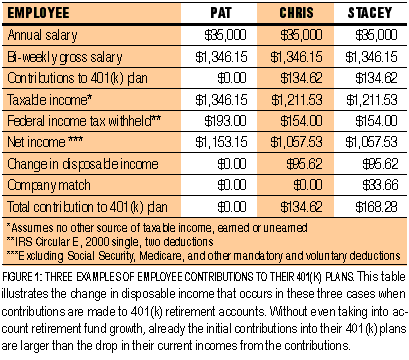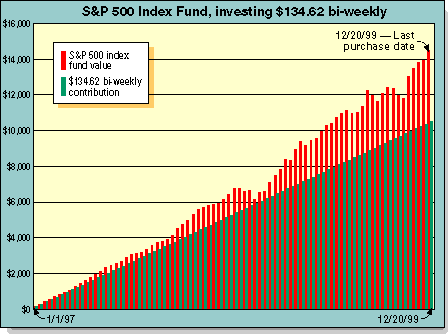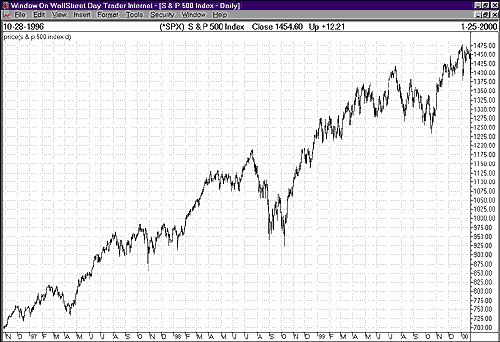
HOT TOPICS LIST
- Strategies
- Stocks
- Buy
- Investing
- Brokers
- Psychology
- Interviews
- Accumulate
- Sell
- Hold
- Spotlight
- Websites
- Candlestick Corner
- Gold & Metals
- Options Trading
LIST OF TOPICS
PRINT THIS ARTICLE
by Linda Gardner
Company or employer matches and deferred taxes make contributing to your 401(k) a good habit for a healthy retirement.
Linda Gardner
PRINT THIS ARTICLE
FINANCIAL PLANNING
Save For Tomorrow, But Live For Today
10/27/00 03:14:09 PM PSTby Linda Gardner
Company or employer matches and deferred taxes make contributing to your 401(k) a good habit for a healthy retirement.
| Making contributions to your 401(k) plan conjures up images of a comfortable retirement: golf courses and leisurely afternoons. However, what should come to mind - whether you're 21 or 51 - are the many rewards you reap today by tucking away those 401(k) dollars for tomorrow. Immediate rewards! Those who tout the numerous benefits of 401(k) investing will tell you that not only are you putting away money for your future when you fund your 401(k) plan, but 401(k) investing also offers rewards to reap now. Thus, the decision to ante up each payday can not only bring you some reassurance that you too may be able to enjoy a more comfortable retirement, but it may also bring more advantages than you realize. At the top of the list for immediate rewards is the tax-deferred status of your 401(k) contributions, meaning you don't have to pay federal income tax on the income you contribute until retirement. Next on the list comes the company-matching provision offered by many 401(k) plans, whereby your employer matches a portion of your contributions. |
| Employer matches Of the employers that offer 401(k) plans, more than 80% have a company-matching provision, meaning your employer will help you fund your account by contributing a certain percentage of what you yourself contribute. If your company offers a 401(k) plan, odds are yours offers some kind of matching program. If so, do you know how much your company matches? Are you contributing enough to take advantage of company-matching funds? One caveat to keep in mind is that many 401(k) matching plans have a vesting schedule. While all the money that you contribute out of your wages is money you own, your employer's matching dollars may not be 100% yours until a few years have gone by, depending on your employer's particular plan. Tax benefits If you are employed by one of the 20% of companies without a matching program, however, don't dismay. You can still benefit from the tax-deferred status of your 401(k) contributions. What does this mean for you, paycheck to paycheck? Take the example of three employees, each earning $35,000 a year. Stacey works for a company that offers a matching program, while Pat and Chris do not. Stacey's employer will match 50% of the first 5% of wages contributed to the 401(k) plan. All three, by nature of their companies' plans, can contribute up to 10% of their gross wages. Each claims single status with two deductions on their W-4 form. As you can see from Figure 1, Pat neglects to save for retirement, while Chris and Stacey contribute regularly to their 401(k) plans. Because Pat isn't getting the tax-deferring benefits of 401(k) investing, he needs to withhold more for federal income tax to meet his tax liability on April 15. In contrast, Chris has stashed away $134.62 per paycheck into her 401(k) plan, and in order to do so, has reduced her disposable income by $95.62. Stacey, on the other hand, with her company-sponsored matching plan, has tucked away a tidy $168.28 per paycheck and, like Chris, has reduced her spending money by $95.62. Pat may have to caddy for the other two on the golf course to supplement his retirement income! |

|
| |
| Good habits Let's say you are now convinced the 401(k) plan offered by your company is a worthwhile investment. However, you fear you won't be able to meet your bills without the additional $95.62 in your pocket each payday. Instead of giving up on the idea of 401(k) investing, here's this opportunity to review your spending and saving habits and recheck your priorities. For example, Stacey might consider ridding herself of her two-a-day latte habit. That way, she can use at least 5% of her gross salary to take better advantage of her company's match of 50 cents per dollar contributed. Pat and Chris, meanwhile, may want to improve their saving habits. Many 401(k) plans allow you to deduct as little as 1% of your gross income per pay period. On $35,000 a year, this would mean $13.46. After contributing at this rate for a few paychecks, you may find you don't miss the $13 and odd change. When this happens, it's time to increase your percentage. If you're likely to let paycheck after paycheck slide by without reevaluating how much more you could be deducting, put yourself on a schedule. Decide to increase your deduction each quarter, each full moon, each birthday, or whatever it takes. If your company offers an annual cost-of-living adjustment, consider putting the entire amount of that wage increase toward your 401(k) plan. If you aced your annual employment review and earned a merit increase, reward yourself by putting half toward an increase in the percentage you're contributing to your 401(k) fund and, perhaps, spending the other half! Select your investments Once you've established your contribution goal -- whether to fund at the 1% level or contribute at the maximum allowable amount -- it's time to decide which mutual funds or money market funds to invest your 401(k) dollars in. If this is your first venture into the world of investing, as it is with many 401(k) participants, your 401(k) plan is a wonderful medium for getting your feet wet in the waters of investing. Your 401(k) plan is a microcosm of the investment world. Although the number of choices you have available are limited, under ERISA regulations, those choices should allow you to build a well-rounded portfolio. You can allocate your dollars into stock, bond, or cash funds. You can analyze your tolerance for risk and choose investments along the risk spectrum, from conservative to aggressive. You can research each investment option thoroughly because, by the nature of your 401(k) plan, the number of options available is limited and thus manageable. You can enjoy the results of your investment decisions by opening each monthly or quarterly statement and reviewing your progress. You can also enjoy the fact that you are taking advantage of the benefits of dollar cost averaging whenever the market is in a down phase. |
| Adding it all up Let's look at the $134.62 that Chris has invested every other week for the last three years. You may remember that Chris is funding at 10% of her gross salary, but she doesn't have a company-matching provision. For simplicity's sake, we won't take into account any increases in her income over the past three years. Although she has eight investment options available in her plan, she decided to put 100% of her contributions into the Standard & Poor's 500 index fund. Chris chose this route based on her own timeline, risk tolerance, and overall financial plan. Figure 2 shows how her money grew. Whether you decide to contribute the minimum and work your way up to the maximum contribution level, or decide to fund your 401(k) plan at the maximum allowable amount from the beginning, you could find yourself well on your way toward 18 holes on the golf course, a leisurely afternoon, or any other activity you find yourself conjuring upon hearing the word retirement. |
 Figure 2: growth of a 401(k) over a three-year period. Chris contributed $134.62 biweekly into her 401(k) over three years and elected to invest it into the Standard & Poor's 500 index fund. Figure 3 shows how well the S&P has performed over this period.  Figure 3: S&P 500, 1997-2000. Here's a chart of the S&P 500, demonstrating how well Chris' fund performed. |
| Title: | Credit Manager |
| Company: | Technical Analysis, Inc. |
| Address: | 4757 California AVE SW |
| Seattle, WA 98116 | |
| Phone # for sales: | 206 938 0570 |
| Fax: | 206 938 1307 |
| Website: | www.traders.com |
| E-mail address: | LGardner@traders.com |
Traders' Resource Links | |
| Charting the Stock Market: The Wyckoff Method -- Books | |
| Working-Money.com -- Online Trading Services | |
| Traders.com Advantage -- Online Trading Services | |
| Technical Analysis of Stocks & Commodities -- Publications and Newsletters | |
| Working Money, at Working-Money.com -- Publications and Newsletters | |
| Traders.com Advantage -- Publications and Newsletters | |
| Professional Traders Starter Kit -- Software | |
PRINT THIS ARTICLE

|

Request Information From Our Sponsors
- VectorVest, Inc.
- Executive Premier Workshop
- One-Day Options Course
- OptionsPro
- Retirement Income Workshop
- Sure-Fire Trading Systems (VectorVest, Inc.)
- Trading as a Business Workshop
- VectorVest 7 EOD
- VectorVest 7 RealTime/IntraDay
- VectorVest AutoTester
- VectorVest Educational Services
- VectorVest OnLine
- VectorVest Options Analyzer
- VectorVest ProGraphics v6.0
- VectorVest ProTrader 7
- VectorVest RealTime Derby Tool
- VectorVest Simulator
- VectorVest Variator
- VectorVest Watchdog
- StockCharts.com, Inc.
- Candle Patterns
- Candlestick Charting Explained
- Intermarket Technical Analysis
- John Murphy on Chart Analysis
- John Murphy's Chart Pattern Recognition
- John Murphy's Market Message
- MurphyExplainsMarketAnalysis-Intermarket Analysis
- MurphyExplainsMarketAnalysis-Visual Analysis
- StockCharts.com
- Technical Analysis of the Financial Markets
- The Visual Investor
